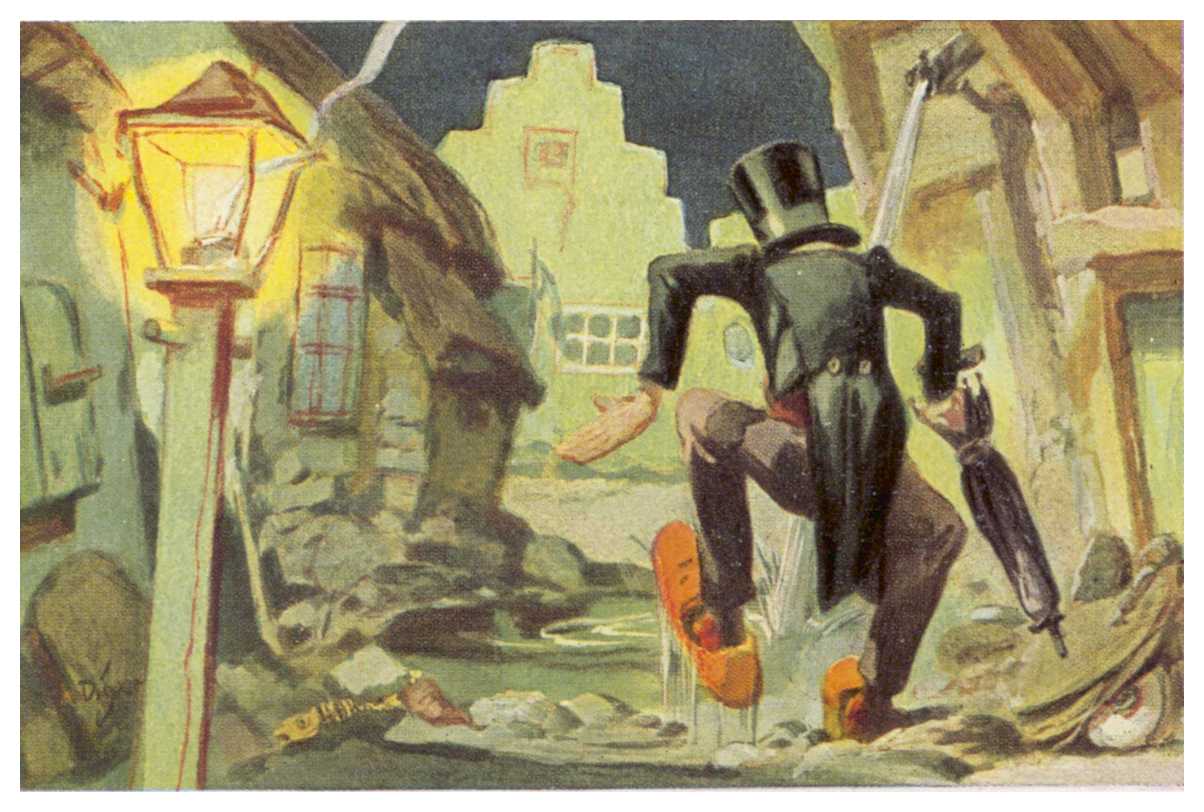

Councillor Knap, a citizen of the 19th century, had been enthusing about the good old days over a few glasses of punch and had wished himself back into that period. With the galoshes of fortune on his feet, that wish was instantly fulfilled. The councillor put it down to the drink when he found himself up to his ankles in mud on unpaved streets unable to find his way home.
This is a rather different portrait of poverty and misery: it is neither compassionate nor critical. For the caricaturist it is quite clear that what is unsound and dilapidated must rightly be considered highly comical and greeted with sardonic laughter. Here Stefan Mart meticulously describes unalleviated decay in the form of a narrow street or lane seen at night dimly lit by the greenish phosphorescent light of its own putrefaction. The yellow light of the sooty street lantern remains weak, restricted to its immediate vicinity. Under the drain-coloured sky, Andersen's Councillor in tails and top-hat picks his way with difficulty between puddles, fish bones and showers of dirty water: he is still partly a Spitzweg character, but already partly a modern toon.
In the 19th century poor parts of cities, especially seen at night, were popular subjects for illustrations. These could be either critical or the Gothic novel type - and sometimes both together. Hell has always been of interest to painters, and from the end of the century it was the infernal aspects of the modern city which provided the cubist-constructivist imagination of painters with nourishment. The demonisation of the city reached its climax in the early 20th century: first in the paintings of the German Expressionists, then in the silent film.
But what has this to do with The Galoshes of Fortune? Andersen's hitting out against romantic idealisation is aimed at the good old days of the late Middle Ages. That is precisely why the story constitutes a problem to the illustrator. How is he to present the Middle Ages as an age of darkness and dilapidation given that all the elements of mediaeval architecture - half-timbered houses, leaded windows, Gothic arches - have such positive connotations? For three hundred years ruins have been celebrated in the arts: the more decayed the ruined walls were, the more beautiful they were considered to be!
Stefan Mart found the solution. He merely gives a suggestion of the mediaeval town with a few brush strokes - all one sees is the gable roof of one single house and a bit of half-timbering. Apart from that, he falls back on elements of Expressionist city paintings, he cites them and uses them to create a montage. Indeed he even seems to ridicule them somewhat. Nonetheless, without having the dramatic city paintings in the back of his mind of artists such as Ludwig Meidner and the cubist architectural representations of Lyonel Feininger (see the picture gallery) he could not have produced his picture of the lane at night. Suchlike cannot be observed, drawn and painted "from scratch".
The prophetic earnestness and emotiveness of the Expressionist models are, of course, lost: they give way to the burlesque. In Ludwig Meidner's paintings the crooked and bulbous distortions of walls and roofs, the refraction of straight alignments, the lopsidedness of buildings and rows of houses are metaphors for the society which is breaking down, for the metaphysical dilapidation of the modern world. The caricaturist on the other hand sees and draws hovels devoid of deeper significance. But he can make use of what is uncanny, "unheimlich" in the Expressionist city scenes, and he harnesses their end-of-the-world mood for his picture. It fits in well with a melancholic fairy tale dealing with a fall into a different epoch, a leap into a different form of existence - things which people find most disquieting, very much to the surprise of youthful, na´ve Goddess Fortuna.